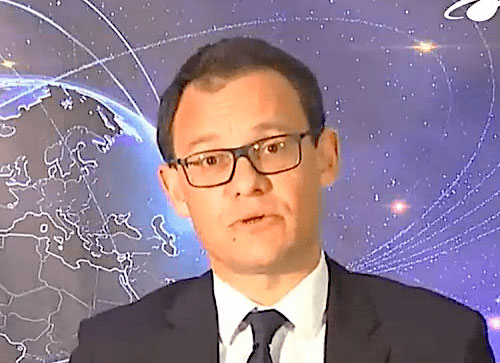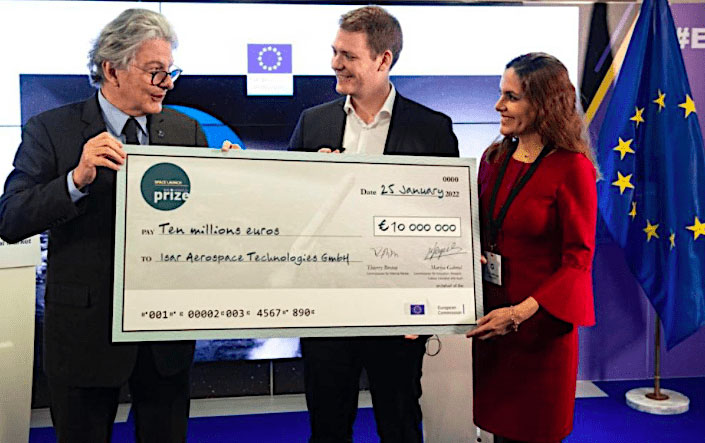PARIS — Arianespace Chief Executive Stephane Israel wasted no time after signing the 18- launch contract with Amazon’s Kuiper to say “I told you so” to Europeans who have doubted the viability of the commercial Ariane 6 rocket, and to European governments he sees as swooning over small launch startups.
Perhaps carried by the updraft of the largest contract — in value and in satellites — in Arianespace’s history, Israel said April 5 that Europe’s Ariane 6 industrial base now needed to consider whether to go beyond its current capacity of 11-12 vehicles per year.
The Ariane 6 contractors, aided with financing fro the 22-nation European Space Agency (ESA), originally sized their capacity to 11-12 Ariane 6 rockets per year. But in recent years, as the geostationary-orbit market declined and SpaceX became the commercial market price leader, the industry has throttled back estimates to seven per year.
And even that figure became credible only after a mid-2021 commitment from European governments that they would guarantee four Ariane 6 missions per year with their own satellites, and pay Ariane contractors 140 million euros ($164 million) if they fell below that rate.
 Stephane Israel. Credit: Arianespace video
Stephane Israel. Credit: Arianespace video
Addressing a press briefing from the 37th Space Symposium in Colorado Springs just hours after the Kuiper deal was announced, Israel said Arianespace’s sense of the current market is that more large constellations are on the way and that 11-12 Ariane 6 missions per year may not be enough.
“I am convinced that not only are we going to do 11-12 Ariane 6 missions per year, but we are asking European industry whether we should not go beyond this capacity,” Israel said. “I can confirm that the space market is in the midst of a rapid expansion. That’s the reality. We’ll have other contracts.”
Israel suggested, but did not say directly, that Arianespace had wanted to limit the size of the Amazon contract to 18 launches so as to leave room for the company’s current customers and for future customers, and for European governments.
“We took account [of discussions with other constellations] in our agreement with Amazon,” he said. “That’s why we ended up agreeing to 18 launches.”
The European Commission and ESA are discussing a low-orbit constellation to provide broadband for Europe and Africa and secure communications links for European governments. If this project goes forward the launches will all go to Arianespace.
To avoid any confusion, Israel said the market growth he’s seeing is large constellations that will seek out large rockets to speed network deployment and lower per-satellite cost.
Competitors Blue Origin, SpaceX and United Launch Alliance have all come to the same conclusion, but in Europe Arianespace has found the Ariane 6 rocket placed in the “Old Space” category -- not new, not reusable and not cool. New Space, according to this reasoning, is for startups, and startups build small rockets.
'Small launchers are for small, niche markets'
Israel sought to use the Kuiper contract as a hammer to drive the point home.
“Micro-launchers have a niche market. It’s a small market,” Israel said. “This does not mean that they have no interest. For example, our corporate parent, ArianeGroup, is interested in MaiaSpace [a proposed small, reusable vehicle], a great idea. It will accelerate the evolution toward a reusable vehicle.”
 The European Commission in January awarded a 10-million-euro cash price to Germany's Isar Aerospace for its small launch vehicle, likely to fly in 2023. Credit: European Commission
The European Commission in January awarded a 10-million-euro cash price to Germany's Isar Aerospace for its small launch vehicle, likely to fly in 2023. Credit: European Commission
“Ambitious projects require large, ambitious launchers. We have seen a striking example of that today,” he said.
The Ariane 6 vehicle that Amazon Kuiper purchased is for 18 launches over three years starting in 2024. Sixteen of these will use a new solid-rocket booster that ESA will propose to its governments at a November ministerial conference.
This expanded booster, called P120C+, will add 2,000 kilograms of performance into low Earth orbit. Israel said the Ariane 6 would carry between 37 and 39 Amazon Kuiper satellites at a time, depending on their final mass and volume and on the inclination of each launch.
Ariane 6 is more than two years behind schedule but the test campaign in 2022 remains busy and it’s not certain the inaugural flight will occur before the end of the year.
Amazon Kuiper contract includes schedule flexibility for Ariane 6
Israel said the Amazon contract includes “resiliencies” that would permit an adjustment to accommodate a minor slip in the Ariane 6 schedule.
Given that Amazon selected three launchers — the Ariane 6, Blue Origin’s New Glenn and ULA’s Vulcan Centaur — that have not yet flown, Israel was asked why SpaceX’s Falcon 9 vehicle was not part of the Kuiper lineup.
Israel said Amazon had always said it was agnostic with respect to launch vehicles and would select based on value for money.
But that doesn’t ring true given SpaceX’s commercial rates and the Falcon 9’s reliability and launch-cadence record.
One industry official who does not work for SpaceX said the company had made a pitch to Amazon, but that Amazon wasn’t interested in feeding the war chest of the owners of Starlink, which is a Kuiper competitor.
Read more from Space Intel Report.
